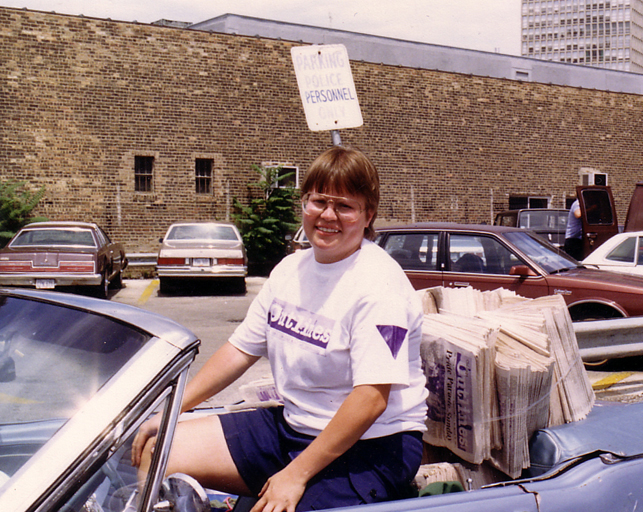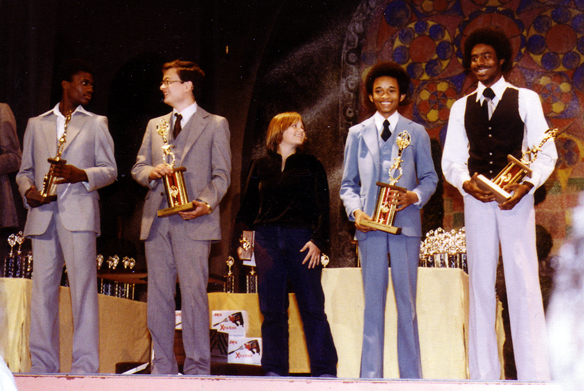
Tracy Baim delivering newspapers in the Chicago Pride Parade, 1987.
For all media companies, innovation is key to better serving a sophisticated audience of web-smart early adopters. Alternative or "niche" media, including LGBT newspapers, are not immune to the dual tsunamis of a down economy and changing media landscape.
When I was 10 years old, in 1973, the first newsletters I produced were for family and friends, and they were handwritten. I soon graduated to my mom's IBM Selectric typewriter, and when I was at Lane Tech High School, I used the Linotype hot-lead-based mega-machines, and have the burn scars to prove it. We even learned handset type techniques, which helped me discover fonts truly hands-on, enough to satisfy any typesetting geek.

Tracy Baim (middle) winning a Midwest typesetting award for handset type, circa 1978. Look at all the great 1970s hair.
While I was in school, the age of phototypesetting machines dawned, including the Mergenthaler and Compugraphic models. I also went with my mom to the plant that printed the Chicago Daily Defender newspaper, and helped paste up the layouts.
I have been lucky to have seen pretty much every aspect of the process of making newspapers over the decades. While I always wanted to be a journalist, I found the process of producing the newspapers just as interesting as the writing, photographing and editing. And this helped me cobble together an early professional career both as a typesetter and a journalist, because I knew how to operate these complicated phototypesetting machines. I worked typesetting late at night to help pay for college, and my first jobs after graduation combined writing and typesetting.
Having multiple skill sets and learning new technology as it develops -- these are still the keys to staying ahead of the curve in the changing media landscape. This is true whether you are the mega-giant New York Times, or niche media serving the lesbian, gay, bisexual, transgender (LGBT) communities.
The niche media we serve at Windy City Times is LGBT. We started in 1985 in the time of phototypesetting. When I left in 1987 to start Outlines newspaper, we made the leap to the new Macintosh 512K by Apple. We were among the first in the country to use these machines to produce a weekly newspaper -- because we were a new company, it made sense to adopt new technology. We also were among the first papers ever to use QuarkXPress, because they, too, were founded in 1987.
By 2000, when I purchased Windy City Times and merged the publications, we were already five years into our use of the "World Wide Web." We went online with all our content because, as a free print publication, we were never threatened by the free nature of the Internet. In fact, I found it a great enhancement, allowing us to have additional content online, quicker and more comprehensive than print space allowed. And it was searchable for research.
Fast forward to 2012, and many niche and mainstream media are struggling. LGBT print media is not immune, even though we serve a traditionally solid demographic group. So I feel fortunate to be able to still do what I love, and I am excited about the changing ways we reach our readers. Most recently, we launched as one of the first few LGBT print media on the Apple iPad Newsstand.
There are no easy steps to keep a niche media company thriving, and every situation is different. And for sure we have made a lot of mistakes along the way. But here are a few examples of changes and innovations we have made to keep serving our community's media needs:
- 1)Cut Overhead. In 2008, we went to a virtual office, allowing our employees to work on the road, or from home, with appropriate technology support. You need a strong team, but for a newspaper company, this is an obvious cost savings.
- 2) Free is Good. There is a trend to try and put content behind paywalls. This may work for massive companies, or ones with a niche no one else can reach. But for most alternative media, a paywall will only separate you from your readers.
- 3)Get Out There. We do community events to help supplement income and stay in touch with the community, but we do only a few key events a year. Some are free for marketing purposes, others are geared to raise funds. But they have to be natural add-ons to our mission, and be low risk. We also donate a large amount of advertising to non-profits, because it is the right thing to do, not because it is profitable.
- 4) Technology is Your Friend. The benefit of being a niche media company is that we don't need focus groups or a year of planning to adopt and adapt to changes. We can launch a new design or new product in weeks.
- 5)Reach Out for Help. Use great outside consultants for technology, legal and accounting. We outsource in key areas, for example to Love Your Website for web development, to keep our focus on our core employee skills. This also gives us consistency because turnover in those areas can cause big problems.
- 6)Teamwork Works. Some of your competitors are out to kill you, while others actually may share your mission and can work with you in your market. We frequently co-sponsor events with other LGBT media, print and online, and sometimes meet to discuss long-term community issues, partnerships and concerns. Not everyone wants this collaboration -- and you have to be careful who you partner with -- but we have seen a nice synergy with some other media, including ChicagoPride.com and Grab. And we are hoping to work with newer media as well -- but only if they play well in the sandbox.
- 7)Know it All. Don't be a know-it-all, but know every aspect of the business. This may seem obvious, but it's actually not easy to really understand every part of doing a newspaper without doing it. I have done delivery routes, taken photos at midnight at a leather bar, designed pages, written and edited, done sales, worked the door at our events, traveled to conferences, and whatever else I would expect anyone else to do. Especially by doing delivery, in the snow or rain, at all hours, I can appreciate the hard work of our team.
- 8)Re-Purpose. We have more than 26 years of content we can use in many ways, not just in print and online, but in collaboration with researchers, students, filmmakers, artists, authors and more. We do ancillary products such as books to enhance our brand. These usually are not money-makers, but they can cement the bond with readers, and show your advertisers you know your niche.
- 9)Be There. As publisher, I post very frequently on Facebook, both personally and through our WCMG Facebook page and Twitter. This creates a high expectation of inter-activity with readers, but it does pay off. We can track how many people enter our website through social media, and it's a very significant number. I can also learn a lot about what stories are of most interest.
- 10)Creative Concepts. While our main core business is supported by advertising, we also seek grant funding for special editorial projects. In 2010 we received a Chicago Community Trust Community News Matters Local Reporting Award to supplement a 10-month AIDS @ 30 reporting project. It helped fund writers for the almost 200 advertising-free pages of stories we published in this series.
- 11)Publish Elsewhere. In 2010, I realized that even though I had written thousands of articles over almost three decades, most were in my own publications. I also saw a dearth of women's voices in mainstream media, and attended a wonderful seminar by the innovative women behind The OpEd Project. They really motivated me to pitch stories to other outlets, and I soon began to blog on Firedoglake and Huffington Post. I don't post all the time, since I do have my own paper to produce, but I find it rewarding to expand the audience for my stories and essays. And it adds to our visibility online.
- 12)Share. A lot of media are upset at sites that aggregate. That horse left the barn a long time ago. I only fight back against those who steal whole stories and images. Sites like Huffington Post link back to our site after using a small amount of our material. This is a good thing. We seek it out.
Finally, even though I sometimes feel disconnected from the mainstream while working in my niche media batcave in Chicago, I read every day about the publishing and journalism worlds. I am a member of journalism and publishing groups. I feel connected to my journalism colleagues in the mainstream, too, even though their battles are different. I also feel so lucky to control my own destiny, being both a publisher and a journalist. It means dealing with news and business, payroll and delivery, print deadlines and online breaking news. But being Chief Juggler has never felt better.
And I owe most of that to the literal and figurative scars from those hot-lead Linotypes and the wicked chemicals of the Mergenthaler phototypesetters. They helped me pay the bills, and pay my dues.
Tracy Baim is co-founder and publisher of Windy City Times.